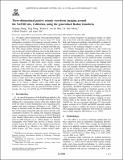Three-dimensional passive seismic waveform imaging around the SAFOD site, California, using the generalized Radon transform
Author(s)
Zhang, Haijiang; Wang, Ping; van der Hilst, Robert D.; Toksoz, M. Nafi; Thurber, Clifford; Zhu, Lupei; ... Show more Show less
Downloadvan der Hilst_Three-dimensional.pdf (596.2Kb)
PUBLISHER_POLICY
Publisher Policy
Article is made available in accordance with the publisher's policy and may be subject to US copyright law. Please refer to the publisher's site for terms of use.
Terms of use
Metadata
Show full item recordAbstract
We apply a three-dimensional (3D) generalized Radon transform (GRT) to scattered P-waves from 575 local earthquakes recorded at 68 temporary network stations for passive-source imaging of (near-vertical) structures close to the San Andreas Fault Observatory at Depth (SAFOD) site. The GRT image profiles through or close by the SAFOD site reveal near-vertical reflectors close to the fault zone as well as in the granite to the southwest and the Franciscan mélange to the northeast of the main fault. Although slightly lower in resolution, these structures are generally similar to features in 2D images produced with steep-dip prestack seismic migration of data from active source seismic reflection and refraction surveys. Our GRT images, however, also reveal several vertical reflectors to the northeast of the SAF that do not appear in the migration images but which are consistent with local geology. These results suggest that in a seismically active area, inverse scattering of earthquake data (for instance with the GRT) can be a viable and, in 3D, economic alternative to an active source survey.
Date issued
2009-12Department
Massachusetts Institute of Technology. Department of Earth, Atmospheric, and Planetary Sciences; Massachusetts Institute of Technology. Earth Resources LaboratoryJournal
Geophysical Research Letters
Publisher
American Geophysical Union
Citation
Zhang, Haijiang et al. “Three-dimensional passive seismic waveform imaging around the SAFOD site, California, using the generalized Radon transform.” Geophys. Res. Lett. 36.23 (2009): L23308. © 2009 by the American Geophysical Union
Version: Final published version
ISSN
0094–8276